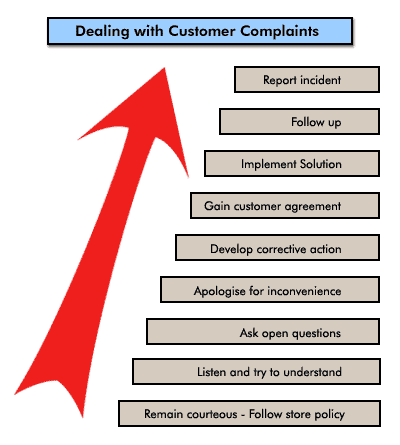
Manage Sales and Service Delivery
Customer Service
In today's
competitive retail environment, your unique selling point (USP) alone
is unlikely to offer a substantial advantage to your store. If it did,
it is likely to be copied or matched by your competitors quickly. The
level of service you offer is often the only difference between you and
your competitors in the eyes of your customers.
It has been
suggested that the cost of acquiring new customers can be five times more
than the cost of keeping your current customers using good service.
Many marketing
textbooks discuss the 'value of life-long customers' to highlight the
dollar value of future sales lost if a customer is dissatisfied. This
in turn impacts on the store's profit.

Effective
customer service helps to keep existing customers.
Who is Responsible For Customer Service?
A common
issue in retail stores is identifying who is responsible for ensuring
that the required level of customer service is applied. Realistically,
every employee is responsible for delivering what the customer requires,
needs and expects.
In the customer's
eyes any employee is the company regardless of their role. The critical
issue in customer service is to ensure that every member of your team
understands this and acts accordingly.
Customer Complaints
If we could 'do it right the first time, every time' we would save significant time and effort plus make a big impact on the store's profit. But, despite our best efforts we sometimes get it wrong. How we handle these dissatisfied customers will determine whether they become lost customers or loyal customers.

In some stores, a customer complaint is seen as a negative situation. This approach takes a limited view of the possibilities. Generally, a customer complaint provides a chance for you to identify and correct store operations that are not up to scratch. In short, a customer complaint is an opportunity to grow and improve.
|
Sometimes customer complaints can be negative experiences especially in the beginning. But if handled effectively, a complaining customer that has their problem satisfactorily resolved can become a positive spokesperson for the store. To a large extent its how you handle the situation that creates the end result. |
When faced with a customer complaint we have the choice of reacting in a negative way or dealing with the complaint in an efficient and caring manner. If your complaint resolution procedures are up to the task, you or your team will be in a position to effectively solve the complaint. If not, they should be reviewed.
Your store policy should reflect this need to deal with complaints positively. A sample policy follows:
|
|||